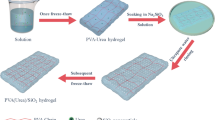Abstract
Scaffolds comprising poly(lactic acid) (PLA) and hydroxyl apatite (HA) were fabricated by combination of the high-pressure compression-molding plus salt-leaching techniques. The optimized HA content was determined in terms of the pore morphology, porosity, storage modulus, degradation behavior, hydrophilicity as well as the cell growth ability of the scaffolds. At HA content of 20 wt%, the scaffolds exhibited an interconnected open pore structure with the high porosity of 82.2 %. More importantly, the storage modulus of PLA/HA scaffolds (87.6 MPa) achieved almost three times higher compared with pure PLA scaffolds, while under low-pressure condition, the increase of modulus caused by HA does not reach 150 %. The obvious contrast indicated that HA and high pressure had a synergistic effect on enhancing mechanical properties of porous scaffolds. It was truly interesting that the hydrophilicity of PLA/HA scaffolds was significantly improved by alkaline hydrolysis treatment, which eventually led to the excellent cellular biocompatibility of the scaffolds, as revealed from the morphology and spreading of the cells cultured in our scaffolds. On the whole, the resultant PLA/HA scaffolds are well-suited candidates for the design of tailor-made matrices in tissue engineering.











Similar content being viewed by others
References
Guo C, Lin PH, Dong YS, Pu YP, Chu CL (2005) Novel fabrication method of porous poly(l-lactic acid) scaffolds using liquid-solid extraction. J Mater Sci 40:1759. doi:10.1007/s10853-005-0686-8
Liao H, Mutvei H, Sjöström M, Hammarström L, Li J (2000) Tissue responses to natural aragonite Margaritifer a shell implants in vivo. Biomaterials 21:457–468
Guo C, Guo X, Cai N, Dong Y (2012) Novel fabrication method of porous poly(lactic acid) scaffold with hydroxyapatite coating. Mater Lett 74:197–199
Dinarvand P, Seyedjafari E, Shafiee A, Jandaghi AB, Doostmohammadi A, Fathi MH, Farhadian S, Soleimani M (2011) New approach to bone tissue engineering: simultaneous application of hydroxyapatite and bioactive glass coated on a poly(l-lactic acid) scaffold. ACS Appl Mater Interfaces 3:4518–4524
Chen G, Okamura A, Sugiyama K, Wozniak MJ, Kawazoe N, Sato S, Tateishi T (2009) Surface modification of porous scaffolds with nanothick collagen layer by centrifugation and freeze-drying. J Biomed Mater Res B 90:864–872
Roco MC (1999) Nanoparticles and nanotechnology research. J Nanopart Res 1:1–6
Zhang J, Yan DX, Xu JZ, Huang HD, Lei J, Li ZM (2012) Highly crystallized poly(lactic acid) under high pressure. AIP Adv 2:2159–2162
Guarino V, Causa F, Taddei P, di Foggia M, Ciapetti G, Martini D, Fagnano C, Baldini N, Ambrosio L (2008) Polylactic acid fibre-reinforced polycaprolactone scaffolds for bone tissue engineering. Biomaterials 29:3662–3670
Sarazin P, Roy X, Favis BD (2004) Controlled preparation and properties of porous poly(l-lactide) obtained from a co-continuous blend of two biodegradable polymers. Biomaterials 25:5965–5978
Zheng L, Yang F, Shen H, Hu X, Mochizuki C, Sato M, Wang S, Zhang Y (2011) The effect of composition of calcium phosphate composite scaffolds on the formation of tooth tissue from human dental pulp stem cells. Biomaterials 32:7053–7059
Koutsopoulos S (2002) Synthesis and characterization of hydroxyapatite crystals: a review study on the analytical methods. J Biomed Mater Res 62:600–612
Gao C, Gao J, You X, Huo S, Li X, Zhang Y, Zhang W (2005) Fabrication of calcium sulfate/PLLA composite for bone repair. J Biomed Mater Res A 73:244–253
Obata A (2010) Electrospun microfiber meshes of silicon-doped vaterite/poly(lactic acid) hybrid for guided bone regeneration. Acta Biomater 6:1248–1257
Ferdous J, Kolachalama VB, Shazly T (2013) Impact of polymer structure and composition on fully-resorbable endovascular scaffold performance. Acta Biomater 9:6052–6061
Shieh YT, Liu GL (2007) Temperature-modulated differential scanning calorimetry studies on the origin of double melting peaks in isothermally melt-crystallized poly (l-lactic acid). J Polym Sci B 45:466–474
Bernazzani P, Sanchez R (2008) Effect of substrate interactions on the melting behavior of thin polyethylene films. Eur Phys J E 26:427–434
Zhao Y, Qiu Z, Yang W (2009) Effect of multi-walled carbon nanotubes on the crystallization and hydrolytic degradation of biodegradable poly(l-lactide). Compos Sci Technol 69:627–632
Wei G, Ma PX (2004) Structure and properties of nano-hydroxyapatite/polymer composite scaffolds for bone tissue engineering. Biomaterials 25:4749–4757
Idicula M, Malhotra S, Joseph K, Thomas S (2005) Dynamic mechanical analysis of randomly oriented intimately mixed short banana/sisal hybrid fibre reinforced polyester composites. Compos Sci Technol 65:1077–1087
Wu L, Ding J (2004) In vitro degradation of three-dimensional porous poly (d, l-lactide-co-glycolide) scaffolds for tissue engineering. Biomaterials 25:5821–5830
Crow B, Borneman A, Hawkin D, Smith G, Nelson K (2005) Evaluation of in vitro drug release, pH change, and molecular weight degradation of poly(l-lactic acid) and poly(d, l-lactide-co-glycolide) fibers. Tissue Eng 11:1077–1084
Lee CT, Huang CP, Lee YD (2006) Biomimetic porous scaffolds made from poly(l-lactide)-g-chondroitin sulfate blend with poly(l-lactide) for cartilage tissue engineering. Biomacromolecules 7:2200–2209
Honarbakhsh S, Pourdeyhimi B (2011) Scaffolds for drug delivery, part I: electrospun porous poly(lactic acid) and poly(lactic acid)/poly(ethylene oxide) hybrid scaffolds. J Mater Sci 46:2874. doi:10.1007/s10853-010-5161-5
Acknowledgements
The authors sincerely thank the financial supports from the National Natural Science Foundation of China (Grant No. 51120135002, 51121001, and 51203104) and the National Outstanding Youth Foundation of China (Grant No. 50925311). The authors also thank Dr. Chen Chen from Sichuan University for assistance with cell culture test.
Author information
Authors and Affiliations
Corresponding author
Rights and permissions
About this article
Cite this article
Zhang, J., Yin, HM., Hsiao, B.S. et al. Biodegradable poly(lactic acid)/hydroxyl apatite 3D porous scaffolds using high-pressure molding and salt leaching. J Mater Sci 49, 1648–1658 (2014). https://doi.org/10.1007/s10853-013-7848-x
Received:
Accepted:
Published:
Issue Date:
DOI: https://doi.org/10.1007/s10853-013-7848-x




